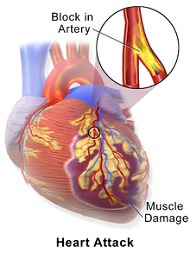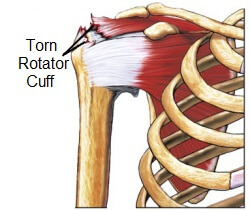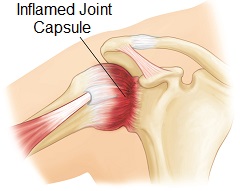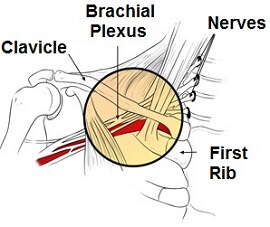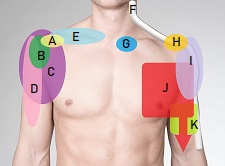- Home
- Diagnosis Guide
- Left Arm Pain
Left Shoulder Pain
Written By: Chloe Wilson BSc (Hons) Physiotherapy
Reviewed By: SPE Medical Review Board
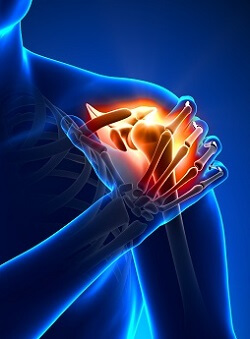
Left shoulder pain can be a big cause for concern. Often people’s first concern is that it might be a heart attack, but unless there is associated shortness of breath, a tight/crushing sensation in your chest, dizziness, nausea or fatigue, it is unlikely to be a heart problem.
Instead, upper left arm pain may be due to a problem in the bones, muscles, ligaments or tendons in the shoulder. The problem may not even stem from the shoulder joint itself but may instead be referred pain from the neck or a pinched nerve. But how can you tell the difference?
Here we will look at the most common causes of left shoulder pain including the common signs and symptoms of each and how to tell if it’s something serious. We will then go on to look at each one in more detail including the best treatment options for each cause of left arm pain.
What Causes Left Shoulder Pain?
The most common causes of upper left arm pain fall into five categories:
- Medical Conditions: Heart Attack, Stroke, Pancreatitis
- Soft Tissue Damage: Rotator Cuff Tear, Tendonitis, Bursitis, Labrum Tear, Trigger Points
- Shoulder Joint Problems: Impingement Syndrome, Frozen Shoulder
- Bone Problems: Fractures, Dislocation, Arthritis
- Spinal/Nerve Problems: Disc Bulge, Trapped Nerve, Brachial Neuritis
Left shoulder pain can affect anyone and may be caused by a number of different issues, which may stem directly from the shoulder joint itself or be referred from surrounding areas.
People who are left hand dominant in particular may suffer from upper left arm pain due to frequent, repetitive use of the shoulder.
Now let’s look at each of these causes of left shoulder pain in a bit more detail. Please remember, any new incidence of upper arm pain should be assessed by your doctor to ensure an accurate diagnosis.
1. Medical Conditions
There are a few medical conditions that may be accompanied by left shoulder pain and whilst they are not the most common causes of left arm pain, they can be extremely serious so we’ll start by looking at those.
Heart Attack
A heart attack is the most serious cause of left shoulder pain. It is typically caused by build-up of plaque in arteries which reduces blood flow to part of the heart muscle. Pain typically starts in the chest and then spreads to the shoulder/arm (most typically the left side) and jaw.
Common Presentation: Tight, crushing, pressure type chest and left shoulder pain, dizziness, shortness of breath, nausea, tingling sensation.
If your left arm pain is accompanied by other symptoms such as tightness in the chest, dizziness, sweating, shortness of breath and nausea, call 911 (or 999 in the UK) immediately. However, if there are no other symptoms associated with your left shoulder pain, the pain only gets worse when you use the arm or only lasts for a few seconds, it is unlikely to be heart related.
Stroke aka CVA
A stroke is caused by an interruption in the blood flow to the brain. In 80% of cases this is due to a blot clot, known as an ischaemic stroke, in 20% it is due to bleeding, known as a haemorrhagic stroke. Whilst pain is not usually the dominant symptom, it can occur, so if you have left arm pain accompanied by the classic signs of a stroke you should call 911 immediately.
Common Presentation: weakness, visual disturbance, slurred speech, dizziness, numbness. The NHS (UK’s National Health Service) recommends using the acronym FAST if a stroke is suspected –
- Face: has it fallen on one side
- Arms: can you raise them
- Speech: is it slurred
- Time: if you have any of these symptoms dial 999/911
Pancreatitis
Inflammation of the pancreas can cause left shoulder pain. Pancreatitis may be caused by gall stones, excessive long-term alcohol intake, certain medical conditions and medications. Pain typically develops after eating and gradually gets more intense and frequent.
Common Presentation: Pain in the middle or upper left side of the abdomen that may spread to the shoulder blade/shoulder, usually left side. Typically develops after eating and is associated with nausea and dizziness
There are a number of other medical conditions that can cause left shoulder pain such as cancer, but usually there will usually be other more noticeable symptoms as well.
2. Soft Tissue Damage
Damage to any of the soft tissues inside or surrounding the shoulder joint can cause left shoulder pain. It may be that there is damage to a muscle, ligaments, tendons or the soft tissues lining the joint.
The most common soft tissue problems that cause left arm pain are:
Rotator Cuff Muscle Damage
Rotator cuff tears are a common cause of left shoulder pain. The rotator cuff is a group of four muscles that surround the shoulder joint and control its movement and stability. Tears can develop gradually over time through wear and tear, typically over the age of 40, or suddenly with an injury typically younger people. The severity of the symptoms will depend on the extent of the tear.
Common Presentation: Sudden or gradual onset of a dull ache deep inside the shoulder and weakness. Activities with the arm above the head or behind the back most commonly affected
You can find out loads more about the causes, symptoms, diagnosis and treatment in the Rotator Cuff Tears section.
Shoulder Tendonitis
Shoulder tendonitis is where there is inflammation or degeneration of the muscle tendons which can lead to left shoulder pain. The location will depend on which of the muscle is affected, most typically supraspinatus tendonitis or biceps tendonitis. Pain tends to be worse with arm movement with minimal pain at rest, and there may be some associated weakness. Upper arm pain from tendonitis is usually caused by repetitive, overhead movements.
Common Presentation: Gradual onset of symptoms with underlying ache around the shoulder and sharp upper arm pain when moving the shoulder or arm, particularly above head height. Sleep often affected.
You can find out loads more about the causes, symptoms, diagnosis and treatment of left arm pain from tendonitis in the Supraspinatus Tendonitis and Biceps Tendonitis sections.
Shoulder Bursitis
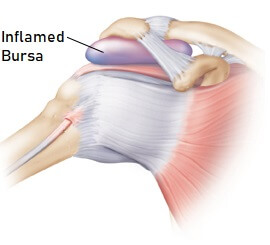
Another possible cause of left shoulder pain from soft tissue damage is shoulder bursitis. Bursa are small fluid filled sacs that sit between bone and soft tissue to allow smooth, friction-free movement. Inflammation from injury or repetitive movements leads to shoulder pain.
Left shoulder pain from bursitis is often accompanied by other problems such as impingement syndrome.
Common Presentation: Low level ache in the shoulder, worse with arm movements. Upper arm pain tends to be localised
You can find out loads more about the causes, symptoms, diagnosis and treatment in the Shoulder Bursitis section.
Labrum Tear
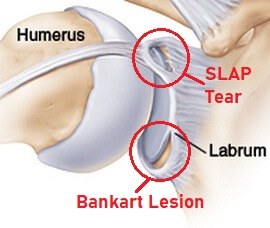
The labrum is a special layer of cartilage that lines the shoulder joint to help improve the stability of the shoulder. With a torn shoulder labrum, as well as pain, there is often instability. The labrum can be damaged by trauma to the shoulder such as a fall, or from repetitive overhead movements or heavy lifting.
A tear at the bottom of the labrum is known as a Bankart Lesion, and a tear at the top is known as a SLAP tear. The pain from a labrum tear is often an ill-defined ache around the shoulder and upper left arm pain rather than over a specific point
Common Presentation: Diffuse pain and instability with occasional catching/locking sensations. Left shoulder pain from a labrum tear usually develops after an injury but can develop gradually from wear and tear
Find out more about the causes, symptoms, diagnosis and treatment of Shoulder Labrum Tears
Trigger Points
Trigger points are often unsuspected causes of left shoulder pain, most commonly located in the trapezius muscle. They are small, tight nodules or bands in the fascia that surround muscles, commonly referred to as “knots”. They are often hypersensitive to touch and can refer pain around the shoulder and down the arm with or without compression of the trigger point. Trigger points are usually treated by massage, acupuncture, injections and/or stretches
Common Presentation: dull, aching, deep pain which may or may not be localised. There may be a small palpable pea-sized lump.
You can find out more about trigger points and how to treat them in the Trapezius Pain section.
3. Shoulder Joint Conditions
There are a few conditions affecting the inside of the shoulder joint that can lead to left arm pain:
Frozen Shoulder
A frozen shoulder can cause left shoulder pain due to joint capsule thickening and tightening. In most cases symptoms develop gradually with no obvious cause, but some people develop a frozen shoulder after an injury or surgery. It can take around 18 months to 2 years to fully recover. Typically only affects one shoulder
Common Presentation: Gradual onset progressing through three phases: Stage 1 increasing shoulder pain with minimal stiffness, Stage 2 increasing stiffness, decreasing pain, Stage 3 stiffness gradually resolves.
You can find out more about the causes, symptoms, diagnosis and treatment options in the Frozen Shoulder section.
Impingement Syndrome
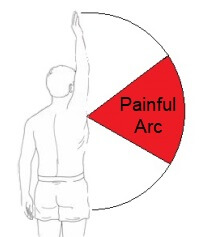
Shoulder impingement syndrome is a common cause of left arm pain and is a collective term for anything that reduces the space in the shoulder joint causing the soft tissues to get trapped. It may be due to bone spurs and/or inflammation of the soft tissues in the joint.
Space in the joint is at its least when the arm is at shoulder height so symptoms tend to be worse around that region, with minimal left arm pain when the arm is low down or right above your head, as shown in the diagram. Sleep is often disturbed as it can be very painful to lie on the affected side
Common Presentation: Sharp, painful arc with shoulder movement, with associated weakness and sleep disturbance.
You can find out loads more about the causes, symptoms, diagnosis and treatment options in the Shoulder Impingement section.
4. Bone Problems
Left shoulder pain can be due to a problem with the bones of the shoulder joint. Possible bone problems that can cause upper arm pain include:
Shoulder Fractures
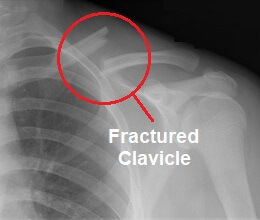
Left arm pain from a shoulder fracture (a break in one of the shoulder bones) is usually associated with a specific injury such as a fall with immediate symptoms. Pain tends to be localised over the fracture site and there may be an obvious deformity. If you suspect your left arm pain is due to a broken bone, you should get it checked out immediately.
Common Presentation: Sudden onset of localised upper arm pain following an injury
You can find out more about the different types of fractures and their causes, symptoms, diagnosis and treatment options in the Shoulder Fractures section.
Shoulder Dislocation
The shoulder joint is held together tightly with muscles and ligaments but the joint socket is shallow putting it at risk of dislocation, most commonly forwards. Usually, it takes a large force to dislocate the shoulder, it doesn’t just “pop out”, unless there are pre-existing problems with stability.
With a dislocated shoulder there will be an obvious deformity and usually severe left arm pain. If you think you have dislocated your shoulder, don’t try to relocate it (put it back in place) yourself, that should be done by a medical professional to minimise damage to the shoulder and surrounding structures
Common Presentation: Sudden onset of left shoulder pain and deformity following an injury
You can find out all about shoulder dislocation symptoms, diagnosis, treatment and recovery in the dislocated shoulder section.
Shoulder Arthritis
Wear and tear (osteoarthritis) or inflammation (rheumatoid arthritis) of the shoulder joint can cause left shoulder pain. As well as upper arm pain, there may be increasing stiffness and grinding/clicking sensations. Osteoarthritis pain tends to affect just one shoulder, whereas rheumatoid arthritis usually affects both.
Common Presentation: Gradual onset of left shoulder pain, often associated with stiffness and grinding. Typically affects people over 50.
5. Spinal or Nerve Problems
Damage or irritation to the nerves that supply the shoulder and arm can cause left shoulder pain. There may be a problem in the neck or somewhere along the path of the nerve that causes pinching, or irritation of the nerve which results in pain and/or altered sensations.
Neck Problems
There are a number of neck problems that can cause upper left arm pain, such as disc bugle, cervical arthritis or a trapped nerve.
Nerves carry signals to and from the brain/spinal cord to muscles regarding movement and sensation. Any irritation to a nerve, such as pinching or inflammation can affect the signal transmission or over sensitize the nerve.
Nerve pain may be felt at the source of the problem e.g. in the neck if there is arthritis or a slipped disc, but in many cases symptoms may be referred down the arm. Left shoulder pain that travels down the arm, with or without neck pain, is often related, at least in part, to neural problems. Depending on where the nerve is irritated, symptoms may be in one or both arms.
Common Presentation: altered sensation e.g. pins and needles/numbness, weakness, left shoulder pain that may radiate down the arm to the elbow, wrist and hand. Symptoms may be bilateral i.e. in both arms
You can find out more about the causes, symptoms, diagnosis and treatment options in the Arm Nerve Pain section.
Brachial Neuritis
Brachial neuritis is a rare problem where the immune system attacks the nerve fibres in the brachial plexus (a bundle of nerves at the root of the neck). Symptoms develop rapidly and get progressively worse. Brachial neuritis is notoriously difficult to diagnose and tends to be one of the less common causes of left shoulder pain.
Common Presentation: Sudden, severe, constant shoulder pain that often starts at night and may spread down the arm. After a few days weakness may develop.
You can find out more about the causes, symptoms, diagnosis and treatment options in the Brachial Neuritis section.
Left Shoulder Pain Diagnosis
Here's a quick summary to help you work out what might be causing your left shoulder pain:
- Aching Shoulder Pain: usually indicates a bone or soft tissue problem – often described as a “nagging toothache” e.g. shoulder bursitis, impingement syndrome, trigger points
- Aching After Activity: usually indicates a muscular problem e.g. rotator cuff tear
- Sharp/Stabbing Pain: structures catching on each other or getting squashed such as ligaments or tendons e.g. biceps tendonitis, supraspinatus tendonitis, labrum tears, impingement syndrome
- Shoulder Stiffness: arm movements limited by stiffness rather than pain typical indicates frozen shoulder
- Burning Pain and/or Altered Sensation: usually indicates a nerve problem e.g. nerve pain or brachial neuritis
- Obvious Deformity: most likely due to a broken bone e.g. fractured collarbone or shoulder fracture, or a dislocated shoulder
- Constant Pain: 24/7 pain that doesn't go away may indicate a heart attack, shoulder fracture or brachial neuritis
- Feeling Unwell: may indicate an underlying medical issue e.g. heart attack, stroke, pancreatitis
Find Out More About Left Arm Pain
You can find out lots more about these common causes of left shoulder pain, including information on symptoms, diagnosis and treatment options by clicking on the links above. If your pain is elsewhere, we can help you work out what is wrong in the shoulder pain diagnosis section.
Most mechanical cases of left shoulder pain respond well to exercise programs to strengthen and stretch the muscles. You can find a whole range of exercises, whatever your level or condition, simply visit the shoulder exercises guide for easy to follow, effective exercise programs.
Related Articles
Page Last Updated: November 5th, 2024
Next Review Due: November 5th, 2026
